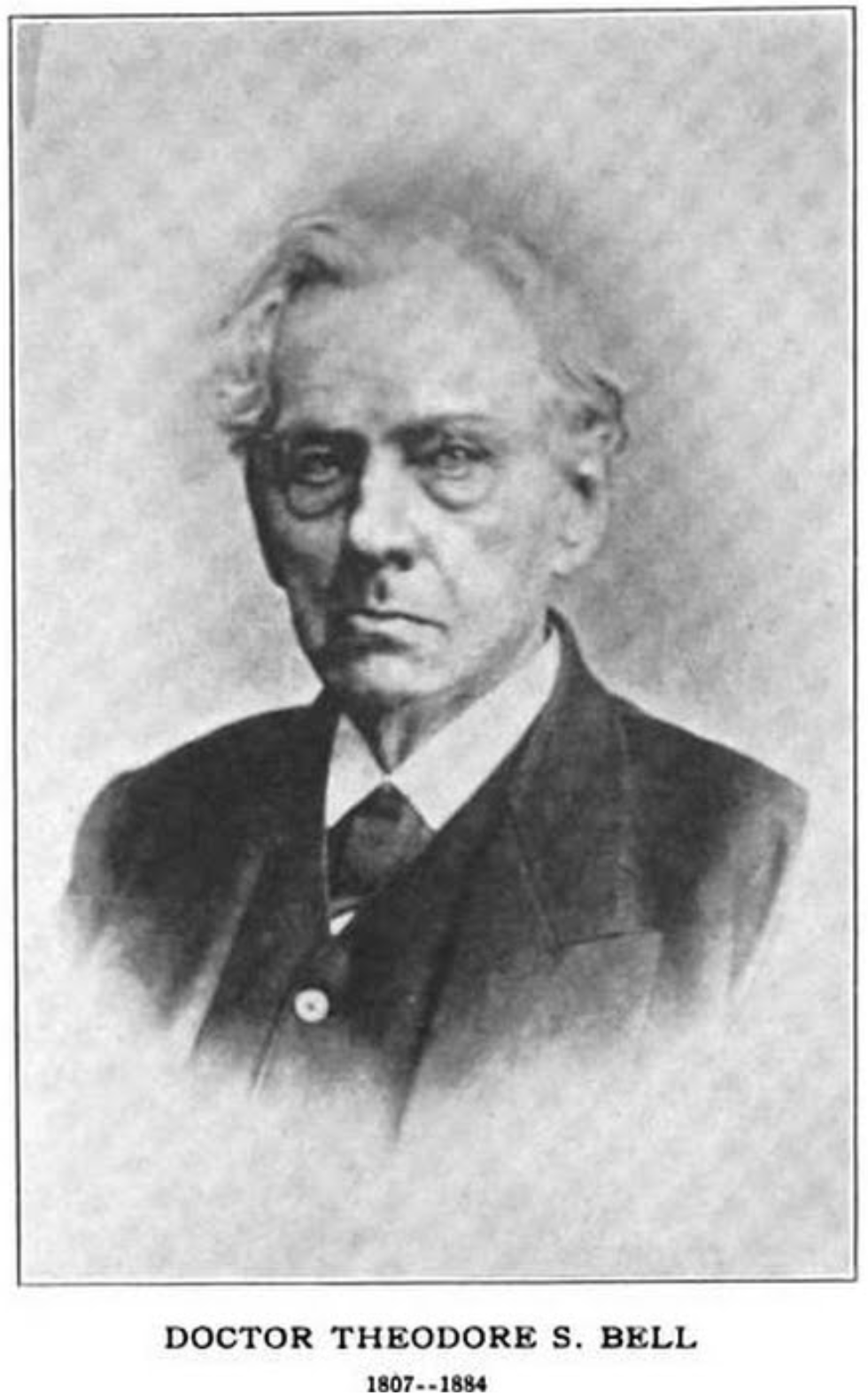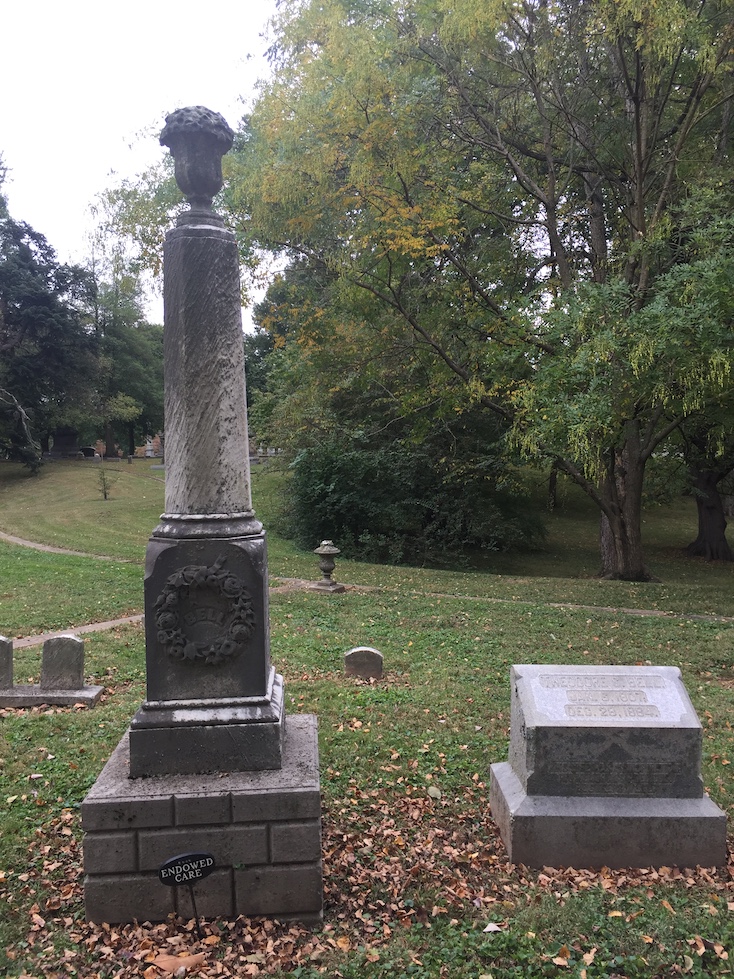Theodore Stout Bell
1807-1884
![]()
Theodore S. Bell
Theodore Stout Bell was a well known and highly influential doctor of medicine. Born in Lexington, Kentucky in 1807, little is known of his childhood. As a youth he entered the work force as a newspaper boy. He then spent six years as an apprentice to a tailor. He was interested in medicine early. He attended and was graduated from the oldest learning institution of the west, Transylvania University in 1832. With a degree in medicine, he moved to Louisville and opened a medical practice. In 1837 he was instrumental in establishing a Medical Institute which later became the University of Louisville.
In 1838, Bell, along with Dr. L.P. Yandell, Sr. began a medical magazine entitled, Louisville Medical Journal. In it he wrote articles about his medical practice. Within a couple of years the paper was named Western Medical Journal. In 1857 he was made professor of a the science and art of medicine and public hygiene. He held this position until his death.
While a student at Transylvania, T.S. Bell came under the influence of the then, reformed Baptist preacher, Jacob Creath, Jr. His preaching led the young college student to realize the signficance of baptism for the remission of sins, and consented to his own obedience of the gospel, being immersed by Creath. Immediately, he began to assist in the building up of New Testament Christianity in the city of Lexington, helping to establish the earliest congregation after the ancient order. He was married to Susan F. Hewitt, a native of Lexington, and member fo the church on April 4, 1833. After moving to Louisville, he connected with the church of Christ in that city where he served to promote the cause of Christ, the remainder of his life. Though a practicing physician, he proclaimed the message of Christ when able, taught the brethren, served as a deacon in the congregation at Louisville, and promoted the cause of Christ the remainder of his life.
-Scott Harp, 02.2019
![]()
T.S. Bell, M.D.
Dr. T. S. Bell, of Louisville, Ky., is well known in connection with almost every great public benevolent enterprise of that city. The records of its daily press, for many years past, fully indicate that the labors of the various official relations he sustains to society must necessarily be enormous. Religious, scientific, mechanical, and agricultural associations, in turn, all lay claim to the labors of his well-stored and active mind and powerful energies; and all this, too, in the midst of an extensive and very laborious medical practice. Added to all else, at the present national crisis, the Government has urged on him one of its most responsible professional trusts in connection with its military arrangements.
In addition to these, he is a man of highly accomplished literary attainments, in which department he is almost enthusiastic. Money has no value to him but as the means of intellectual culture and moral power. The world-renowned "Louisville Journal" owes much of its fame and influence to the frequent effusions from his powerful pen found in its columns.
He has ever been a friend and supporter of pure translations of the Word of God, and hence was forward in advancing the interests of the American Bible soon after its organization. In furtherance of its objects, he was one of the seven who laid the foundation of the Bible Revision Association, as an auxiliary to the former institution. In prosecuting its objects, it became his duty, in connection with James Edmonds, its corresponding secretary, to defend the Society against the misrepresentations of its enemies, in the columns of the daily press, in which they were opposed by five Pedobaptist clergymen. This proved to be a voluminous discussion, and was afterward published in book form, by order of the Association.
The Doctor is what the world calls a lay-member in the Christian Church, having never assumed, nor been appointed, regularly to the ministry of the Word, and having been always engaged in secular pursuits; yet he has been a public man among the brethren, and occasionally a teacher, from his youth up.
He has the appearance, as the portrait indicates, of possessing a powerful physical organization, susceptible of great endurance. This has been fully tested by the laborious and exhausting life he has led. For fifty years of that life his vital and recuperative power was such that he never needed more than four hours’ sleep per diem. This has enabled him to explore every field of sound literature, and almost every department of science, so that few men are more extensively read than he. Under his accumulated labors, his health, of late, began to fail, but is again improving, after a little relaxation from toil.
The subject of this sketch was born in Lexington, Ky., January 6, 1807. His early religious training was in the Bible, by a Baptist mother, who seems to have been opposed to all human creeds. Hence he very early became interested in the sacred volume, which interest has increased with his years and strength, and he has spared no pains to obtain a correct knowledge of its contents.
He was immersed, on confessing faith in the Christ, and for the remission of sins, by Jacob Creath, Jr., in the city of his nativity, in the year 1830. This was when the Baptists of Kentucky were under the influence of the great bug-bear known as "Campbellism." And, as it occurred among Baptists, and by a Baptist preacher, this immersion, together with that of a young Presbyterian publisher, occurring at the same time, became the occasion of much disturbance, which led to "many clerical decapitations."
Soon after his immersion, in company with one or two others, he commenced holding meetings, at the residence of his mother, every Lord’s-day, to "break the loaf." These meetings soon increased in numbers, until there were about seventy-five members, and were the foundation of the Church in Lexington. In 1832, he removed to Louisville, where he has continued to reside to the present time. He united with the Church as soon as convenient after his arrival. Here his knowledge and capacity as a teacher were soon called into exercise. He was its principal teacher for about three years, during which time the Church prospered greatly.
Several public speakers having moved into the city, he ceased to exercise his gift. After some time, difficulties arose in the Church, on account of which Brother Bell and some others requested letters, and withdrew, for the purpose of forming a new congregation.
During the great meeting of 1855, held by D. P. Henderson, he reunited with the parent Church, and has been ardently interested in its success ever since.
With the materials at my disposal, I would rejoice to enlarge upon the subject in hand, but the plan of my work forbids.
Dr. Bell is of a heavy, square-built, bony frame, indicating, when in health, a man of medium height, weighing not less than one hundred and seventy pounds; but, since his late illness, his weight is considerably reduced, so that one would not suppose him to weigh more than one hundred and fifty. His countenance is a fair indication of the mind within. Depth, force, and power, rather than elegance, brightness, and display, are its obvious characteristics.
The large brain, large bony features, and broad chest, betoken a man whose influence is sensibly felt in every circle in which he moves.
-M.C. Tiers, The Christian Portrait Gallery, pages 159-162
![]()
Dr. Theodore S. Bell
Theodore Stout Bell, philanthropist, physician, teacher, writer and philosopher, was born in Lexington, Kentucky, in 1807. He was of humble parentage and, losing his father in childhood, was put to work for the support of his widowed mother. He began life as a newsboy and later learned the tailoring trade. His love of learning soon asserted itself, in spite of unfavorable surroundings he made real advancement in the acquisition of knowledge. The words of Edward Holmes, spoken of a famous old world musical genius, appropriately apply to Bell: “Such a career is hardly to be conceived unsupported by the consciousness of a great destiny, and its secret sustaining from within.” Indeed, the only evidence of vanity he ever displayed was in the exhibition of the needle with which he supported himself and mother while he was acquiring the rudiments of his education.
He was ably assisted in his studies by Mr. James Logue, a learned teacher in Lexington, who without pay devoted his after school hours to teaching this boy, whose talents gave promise of a brilliant future. Later Bell studied with the great surgeon. Dudley, who found for him a way to enter Transylvania School of Medicine, from which he graduated in the year 1832, and soon thereafter came to Louisville, where for 52 years he lived and labored for the fame of medicine and the glory of humanity. Though no politician there was no public measure for good that did not enlist his sympathy and support. Notably in this line was his effort to bring the Transylvania University to Louisville. This failing, he was largely instrumental in the creation of the Louisville Medical Institute, which called Cladwell, Yandell and Cooke to Louisville, and out of which grew the University of Louisville. He wrote voluminously in behalf of the development of his City, and in favor of public improvements.
He was editorially with the Louisville Journal and was the family physician of its great editor, George D. Prentice. In 1838, with Dr. L.P. Yandell, Sr., he founded the Louisville Medical Journal and later, in 1840,41, with Yandell and Dr. Henry Miller, established the Western Journal of Medicine and Surgery.
In 1857 he was made professor of the Science and Art of Medicine and Public Hygiene in the University of Louisville, a position which he held until his death. In 1833 he married Susanne Hewitt, a sister of one of Louisville’s most famous physicians Dr. R. C. Hewitt. To this union was born one child, a son, Carson Hewitt Bell. In 1861 he was made president of the Kentucky branch of the United States Sanitary Commission. The Kentucky Institute for the Blind, for whose promotion he labored with fond solicitude under his influence and wise counsel as president of its board of visitors, became of the foremost institutions of its kind in America.
Dr. Bell was a man of vast and varied learning, and a writer of peculiar grace and force. His medical writings embrace a wide range of topics but his favorite themes were hygiene and the epidemic diseases. His career antedated the bacteriological era. It is true that the Bacillus Anthracis had been seen in the blood of infected animals by Pollender in 1849 and by Davaine in 1850, who, in 1863, demonstrated its causal relation to Charbon, and that Pasteur in 1879 established its identity by pure culture, and that Koch had discovered the bacillus tuberculosis in 1882, but Bell did not live to see the era of bacterio-logical medicine, nor did he ever come to a clear understanding of the causal relation of microbes to anthrax and tuberculosis; while he scorned the doctrine that epidemic diseases like cholera, yellow fever, the bubonic plague, and malaria, could be caused by anything but his three etiological factors, heat, moisture, and vegetable decomposition and the statement that malaria is caused by plasmodium carried by the mosquito, would have shocked his nerves beyond recovery. So powerfully, and so plausible did Dr. Bell urge and seemingly demonstrate his erroneous theories that they attracted the attention of medical magnates abroad and caused some of his students to go to their death in certain yellow fever, and cholera, epidemics of the South, vainly trusting in his sovereign prophylactics, to-wit: high sleeping apartments and quinine; while many of our citizens lost their lives in the epidemic of 1878, because of his unequivocal contention that yellow fever could not develop a single indigenous case, in the place of the latitude, and daily mean temperature, of Louisville. His memorable “isothermic line” so far as it defined the limits of the great epidemics, like Mason and Dixon’s Line and its supposed limitation of the area of slavery, went into the limbo of the unproved and impracticable. Dr. Bell was a savage controversialist and in his many word battles generally downed his opponent with the scorn of invective sarcasm, yet he was gentle and affectionate in disposition, loving his friends and not hating his enemies.
He was an almost incessant reader, having his tables and even his bed piled with books which he read and studied far into the night, allowing himself only four hours of the twenty-four for sleep.
Dr. Bell was, in the true sense of the word, a Christian man. No life more fully than his illustrated the teachings of Jesus Christ. He sold all that he had and gave to the poor, and literally took no thought for the morrow, knowing that He who marks the fall of the sparrow and heeds the young raven’s cry for food, would keep his covenant with his aged, faithful servant.
He died alone and unattended, but this was as he wished to die. At least it was his oft expressed desire that he might fall with the harness on. On the day before his death he was, though in very feeble health, attending to his practice, and on the morning when his dead body was found, it was evident from the condition of the room that he had passed much of the night at his desk with his books, as was his won’t. This seeming austerity fo manner argues not in heart. No man had more friends than Dr. Bell; no man loved his friends better than he, or was better loved in return by his friends. His death, although his span of life had measured almost the full limit of the Psalmist, carried sorrow to very many hearts, and seem to awaken in the whole community the sense of an irreparable loss. Thousands thronged to view his body as it lay in state, and his obsequies were those of a patriarch.
It is fitting that we close with the eloquent tribute written by Dr. E.S. Gaillard, who, during his sojourn in Louisville, was editor of the Richmond and Louisville Medical Journal,, and a professor in a rival school. He had more than one tilt with Bell, who had scorned him most unmercifully. Dr. Gaillard’s feet were on the brink of the dark river when he wrote this noble, just and forgiving tribute: De mortise nil nice bonus:
“He deserved well of his generation, and whatever may be the encomiums it shall render, the just will way that he was worthy of them all. Even those who were not permitted to be the intimates of Dr. Bell must feel sad over the end of such a life; over the longly termination of a life so strong, so useful, so worthy, so admirable; this sad, almost mysterious passing away of a rugged, lonely, strong and genuine man. How like his last days to those of Thomas Carlyle: secluded, sad, yet laborious, independent, useful. The last day, the last hours, spend in work; and when the golden bowl was broken it was, as ever, beside the fountain where it had so often been filled to overflowing. Where else should the mental laborer wish to die, if not amid the silent companions of his life-work? A lonely, solitary death; but an eloquent one, for it declares the choice and character of a well-spent life!”
by Henry A. Cottell, A. M., M.D. Louisville.
Kentucky Medical Journal, Volume XV, January 1917 to December, 1917, pages 100-103
![]()
Directions To Grave
T.S. Bell is buried in the Cave Hill Cemetery in Louisville, Kentucky. The cemetery is located at 791 Baxter Ave. (Hwy. 31). From I-64 take Exit 8 and turn left (west) go to next traffic light (should be Hwy ALT-60) Should see the cemetery on the right. However you will need to enter the cemetery from the Hwy. 31-E (Baxter Ave.) entrance. You can go to the office to get a cemetery map or look at the map below as the exact location. The plote is: Section M, Lot 36.
While At Cave Hill Be Sure To Visit The graves of several other gospel preachers. See map here.
GPS Coordinates
38.246692, -85.721516
View Larger Map
Cave Hill Cemetery
731 Baxter Ave.
Louisville, Kentucky 40204
#502-584-8363
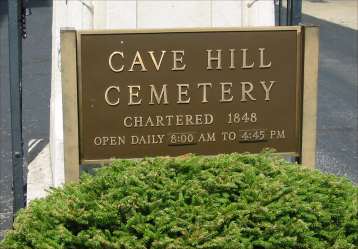
![]()
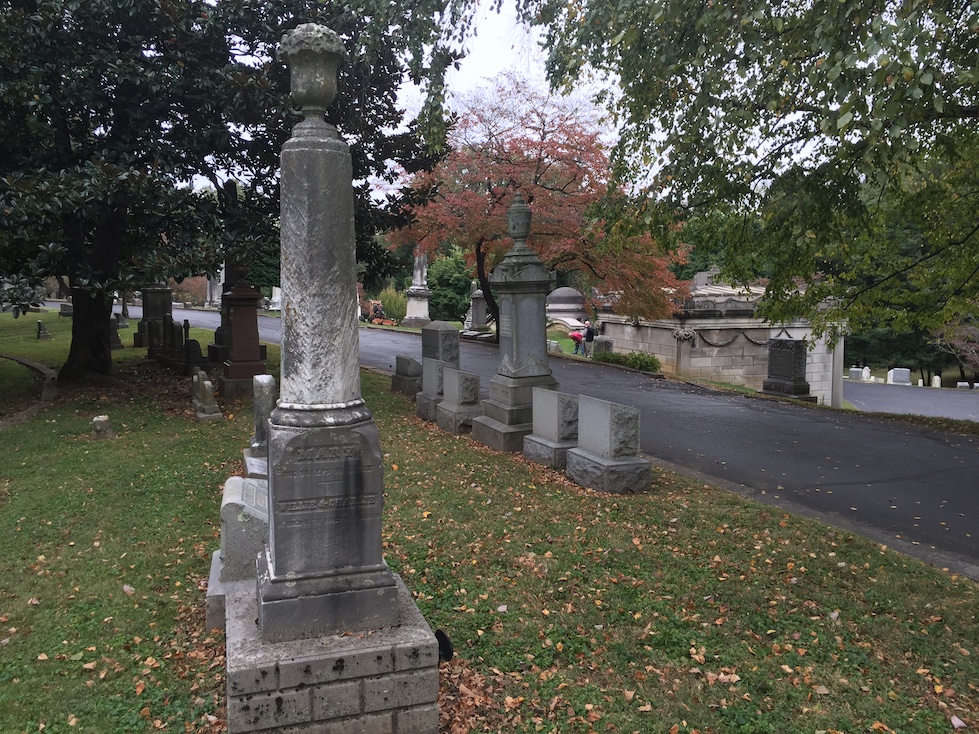
The Bell Plot - In the distance is the plot of M.C. Kurfees
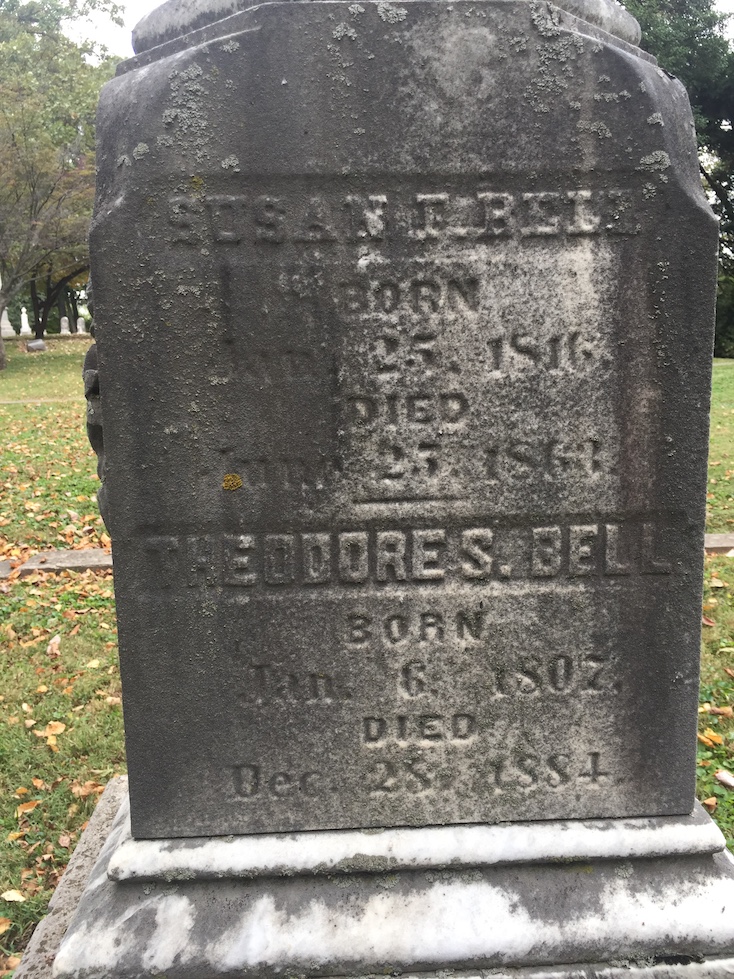
Susan F. Bell
Born
January 25, 1816
Died
June 23, 1863
__________________
Theodore S. Bell
Born
Januyary 6, 1807
Died
December 28, 1884
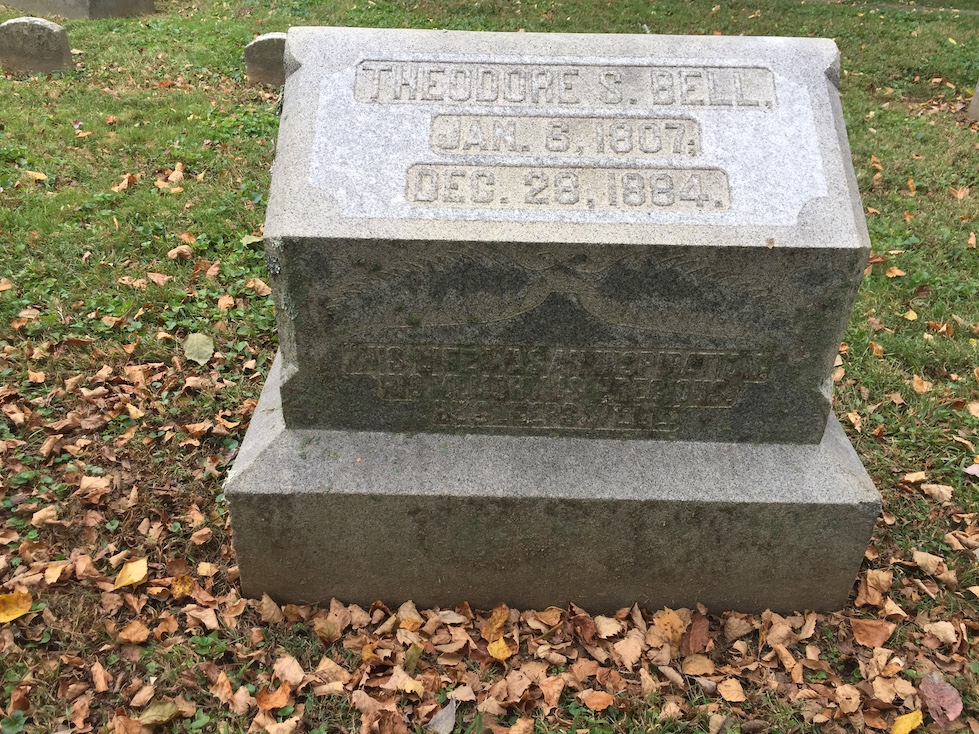
Theodore S. Bell
January 6, 1807
December 28, 1884
![]()
Photos Taken October 14, 2016
Webpage produced February 22, 2019
Courtesy Of Scott Harp
www.TheRestorationMovement.com
![]()
